
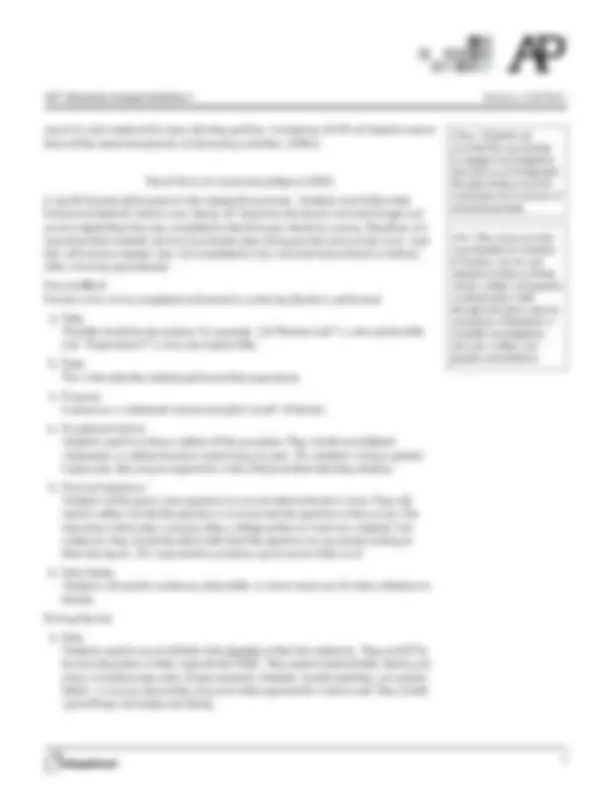
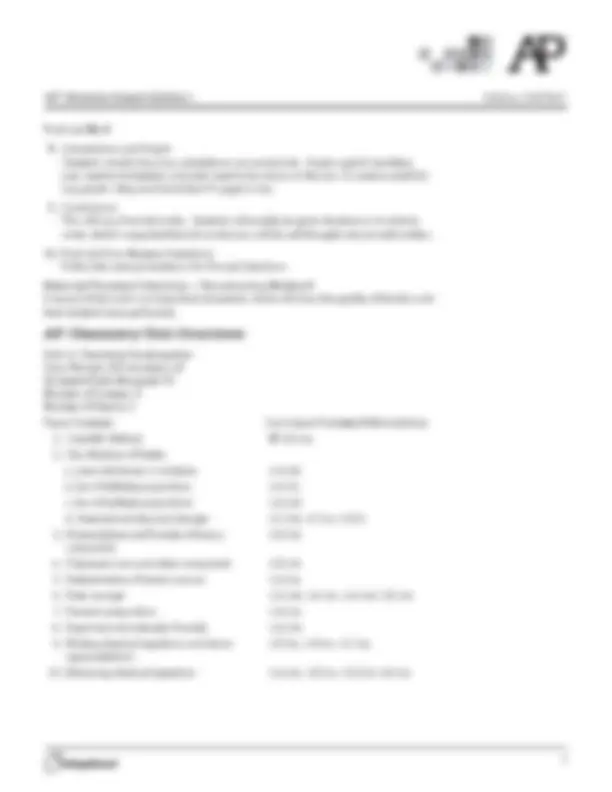
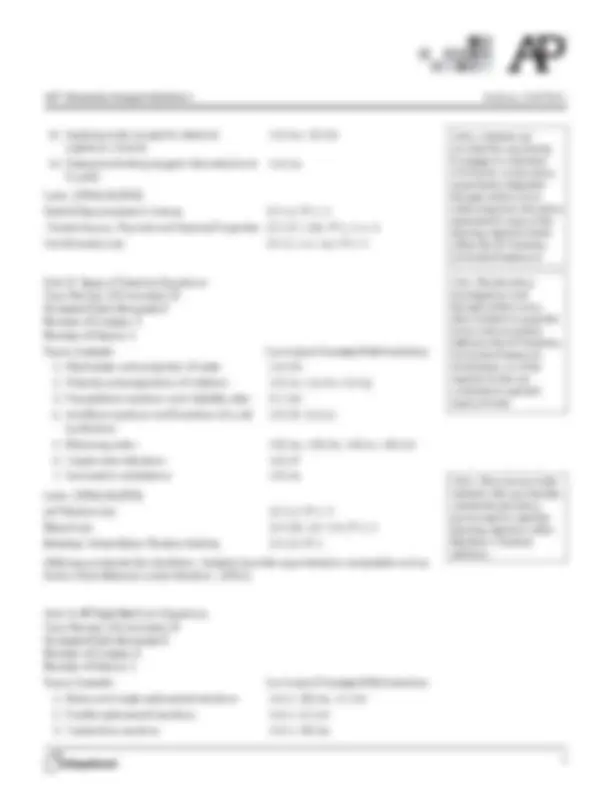
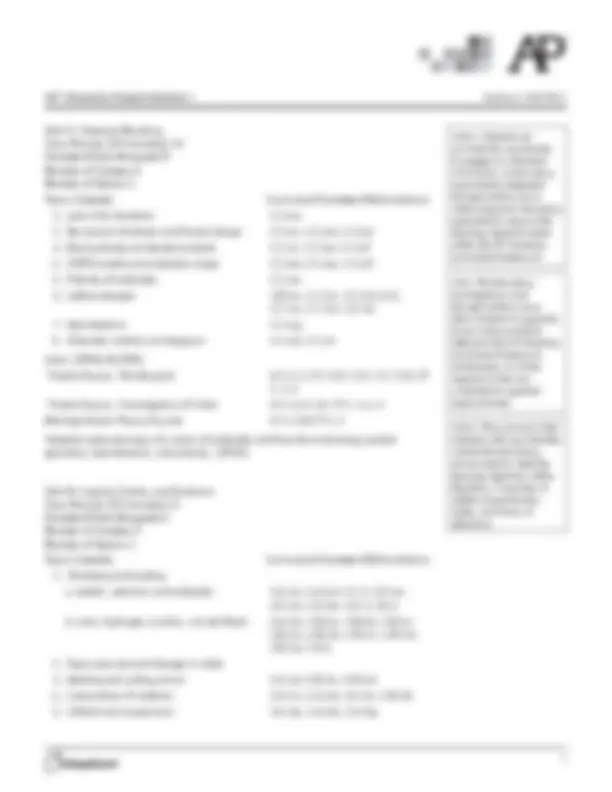
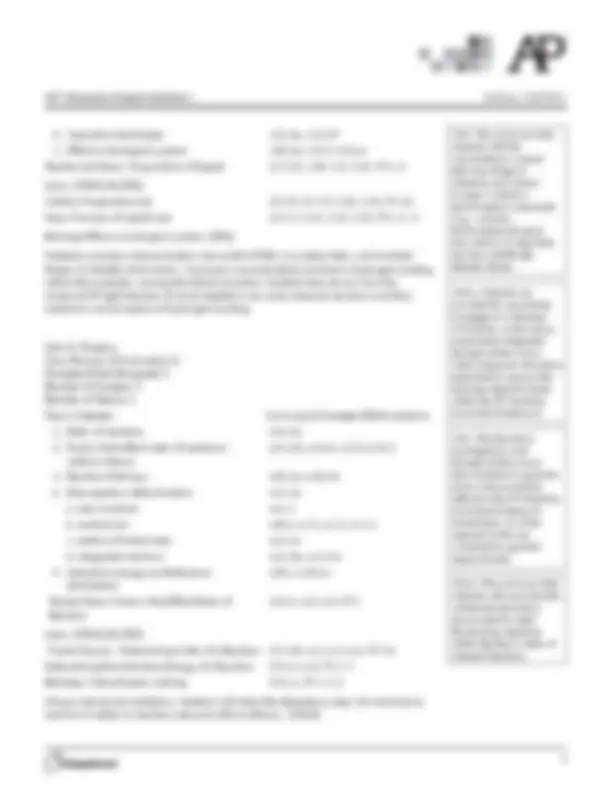
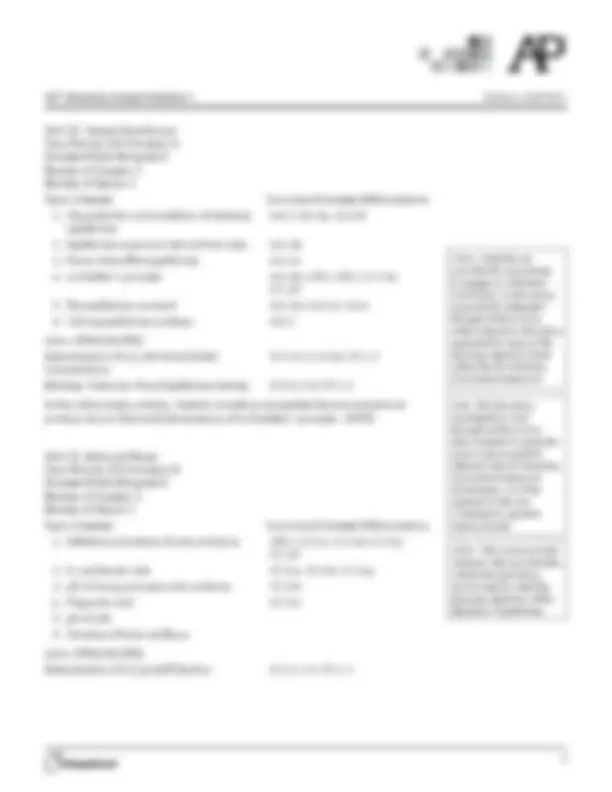
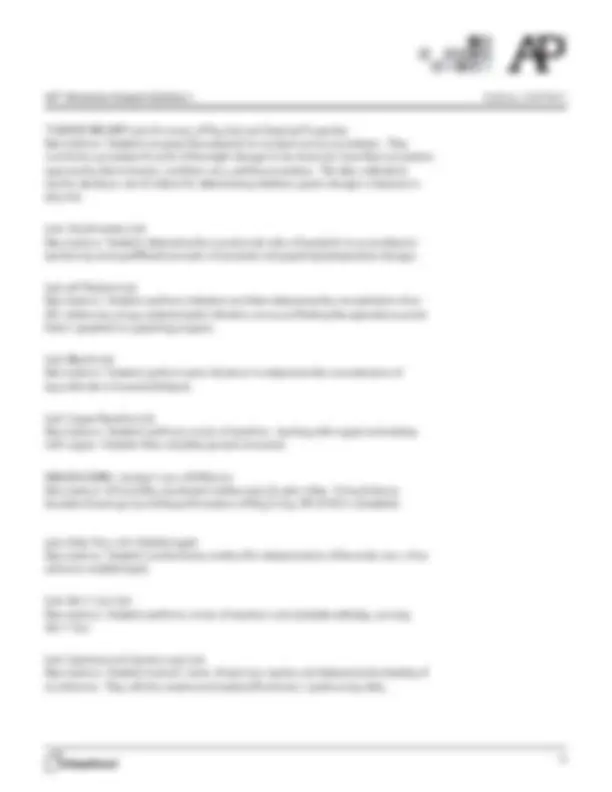
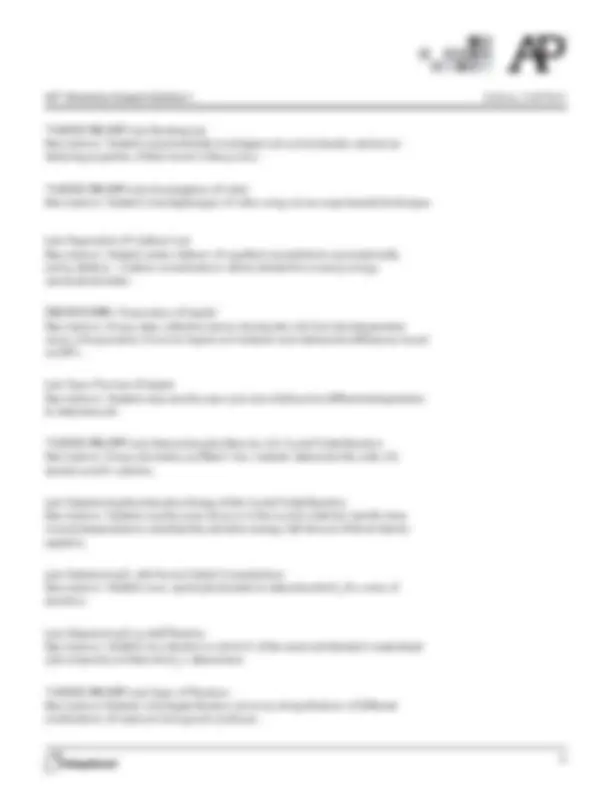
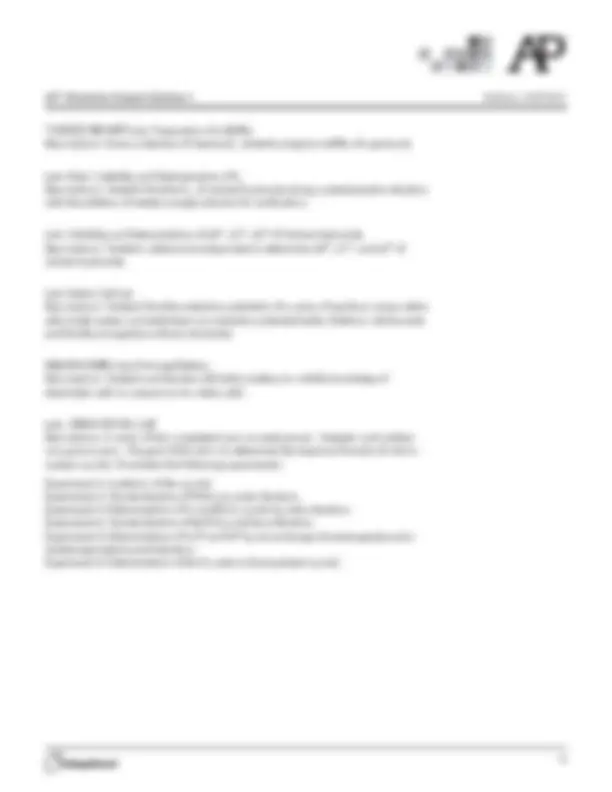


Study with the several resources on Docsity

Earn points by helping other students or get them with a premium plan


Prepare for your exams
Study with the several resources on Docsity

Earn points to download
Earn points by helping other students or get them with a premium plan
Community
Ask the community for help and clear up your study doubts
Discover the best universities in your country according to Docsity users
Free resources
Download our free guides on studying techniques, anxiety management strategies, and thesis advice from Docsity tutors
The structure and content of an AP Chemistry course, focusing on the opportunities for students to engage in investigative laboratory work and hands-on experiments. The course covers various topics, including Curriculum Framework Articulation, Math & Measurement in Science, Chemical Equations, Thermochemistry, Atomic Structure and Periodicity, Chemical Bonding, Liquids, Solids, and Solutions, Kinetics, and General Equilibrium. Students are expected to apply the seven science practices defined in the AP Chemistry Curriculum Framework and develop communication skills through laboratory reports and presentations.
Typology: Lecture notes
1 / 15

This page cannot be seen from the preview
Don't miss anything!










Curricular Requirements Page(s) CR1 Students and teachers use a recently published (within the last 10 years) college-level chemistry textbook. 1 CR2 The course is structured around the enduring understandings within the big ideas as described in the AP Chemistry Curriculum Framework. 1 CR3a The course provides students with opportunities outside the laboratory environment to meet the learning objectives within Big Idea 1: Structure of matter. 6 CR3b The course provides students with opportunities outside the laboratory environment to meet the learning objectives within Big Idea 2: Properties of matter-characteristics, states, and forces of attraction. 7 CR3c The course provides students with opportunities outside the laboratory environment to meet the learning objectives within Big Idea 3: Chemical reactions. 4 CR3d The course provides students with opportunities outside the laboratory environment to meet the learning objectives within Big Idea 4: Rates of chemical reactions. 8 CR3e The course provides students with opportunities outside the laboratory environment to meet the learning objectives within Big Idea 5: Thermodynamics. 6 CR3f The course provides students with opportunities outside the laboratory environment to meet the learning objectives within Big Idea 6: Equilibrium. 9 CR4 The course provides students with the opportunity to connect their knowledge of chemistry and science to major societal or technological components (e.g., concerns, technological advances, innovations) to help them become scientifically literate citizens. 8 CR5a Students are provided the opportunity to engage in investigative laboratory work integrated throughout the course for a minimum of 25 percent of instructional time. 2 CR5b Students are provided the opportunity to engage in a minimum of 16 hands-on laboratory experiments integrated throughout the course while using basic laboratory equipment to support the learning objectives listed within the AP Chemistry Curriculum Framework. 4, 5, 6, 7, 8, 9, 10, 11 CR6 The laboratory investigations used throughout the course allow students to apply the seven science practices defined in the AP Chemistry Curriculum Framework. At minimum, six of the required 16 labs are conducted in a guided-inquiry format. 4, 5, 6, 7, 8, 9, 10, 11 CR7 The course provides opportunities for students to develop, record, and maintain evidence of their verbal, written, and graphic communication skills through laboratory reports, summaries of literature or scientific investigations, and oral, written, and graphic presentations. 2
This AP Chemistry course is designed to be the equivalent of the general chemistry course usually taken during the first year of college. For most students, the course enables them to undertake, as a freshman, second year work in the chemistry sequence at their institution or to register in courses in other fields where general chemistry is a prerequisite. This course is structured around the six big ideas articulated in the AP Chemistry curriculum framework provided by the College Board. [CR2] A special emphasis will be placed on the seven science practices, which capture important aspects of the work that scientists engage in, with learning objectives that combine content with inquiry and reasoning skills. AP Chemistry is open to all students that have completed a year of chemistry who wish to take part in a rigorous and academically challenging course. Big Idea 1: Structure of matter Big Idea 2: Properties of matter-characteristics, states, and forces of attraction Big Idea 3: Chemical reactions Big Idea 4: Rates of chemical reactions Big Idea 5: Thermodynamics Big Idea 6: Equilibrium
The College Board. AP Chemistry Guided Inquiry Experiments: Applying the Science Practices. 2013. Zumdahl, Steven and Susan Zumdahl. Chemistry, Eighth Edition. Belmont CA: Cengage Learning, 2012. [CR1] Demmin, Peter. AP Chemistry, Fifth Edition. New York: D&S Marketing Systems Inc.,
Vonderbrink, Sally. Laboratory Experiments for AP Chemistry. Batavia: Flinn Scientific,
Randall, Jack. Advanced Chemistry with Vernier. Oregon: Vernier Software and Technology, 2004. Holmquist, Dan and Donald Volz. Chemistry with Calculators. Oregon: Vernier Software and Technology, 2003. Beran, Jo Allan. Laboratory Principles of General Chemistry, Seventh Edition. New York: John Wiley and Sons, 2004.
Graphing calculator, splash proof goggles, and a carbon capable laboratory notebook
The labs completed require following or developing processes and procedures, taking observations, and data manipulation. See lab list provided for lab details. Students communicate and collaborate in lab groups; however, each student writes a laboratory CR2—The course is structured around the enduring understandings within the big ideas as described in the AP Chemistry Curriculum Framework. CR1—Students and teachers use a recently published (within the last 10 years) college-level chemistry textbook.
Post-Lab Work
8. Calculations and Graphs Students should show how calculations are carried out. Graphs need to be titled, axes need to be labeled, and units need to be shown on the axis. To receive credit for any graphs, they must be at least ½ page in size. 9. Conclusions This will vary from lab to lab. Students will usually be given direction as to what to write, but it is expected that all conclusions will be well thought out and well written. 10. Post Lab Error Analysis Questions Follow the same procedure as for Pre-Lab Questions. Advanced Placement Chemistry — The Laboratory Notebook A record of lab work is an important document, which will show the quality of the lab work that students have performed.
Unit 1: Chemistry Fundamentals Class Periods (52 minutes): 12 Homework Sets Assigned: 10 Number of Quizzes: 2 Number of Exams: 1 Topics Covered: Curriculum Framework Articulation:
CR5b—Students are provided the opportunity to engage in a minimum of 16 hands-on laboratory experiments integrated throughout the course while using basic laboratory equipment to support the learning objectives listed within the AP Chemistry Curriculum Framework. CR6—The laboratory investigations used throughout the course allow students to apply the seven science practices defined in the AP Chemistry Curriculum Framework. At minimum, six of the required 16 labs are conducted in a guided- inquiry format. CR3c—The course provides students with opportunities outside the laboratory environment to meet the learning objectives within Big Idea 3: Chemical reactions.
Labs: [CR5b] & [CR6] *Guided Inquiry: Hess’s Law Lab LO 3.11, 5.3-5.5, 5.7, 5.8; SP 2, 5, 3, 4, 6 Activity: Online Heating and Cooling Curve Simulations
Utilizing the eduweb lab simulation website, students heat an unknown and graph its temperature as it cools, giving them the ability to calculate the energy released. [CR3e] Unit 6: Atomic Structure and Periodicity Class Periods (52 minutes): 12 Homework Sets Assigned: 9 Number of Quizzes: 4 Number of Exams: 1 Topics Covered: Curriculum Framework Articulation:
Unit 7: Chemical Bonding Class Periods (52 minutes): 11 Homework Sets Assigned: 8 Number of Quizzes: 4 Number of Exams: 1 Topics Covered: Curriculum Framework Articulation:
Unit 10: General Equilibrium Class Periods (52 minutes): 6 Homework Sets Assigned: 4 Number of Quizzes: 3 Number of Exams: 1 Topics Covered: Curriculum Framework Articulation:
Activity: Online Gas Phase Equilibrium Activity LO 6.8, 6.9; SP 1, 6 In the online inquiry activity, students are able to manipulate the environment and produce stresses that verify the tendency of Le Chatelier’s principle. [CR3f] Unit 11: Acids and Bases Class Periods (52 minutes): 8 Homework Sets Assigned: 4 Number of Quizzes: 3 Number of Exams: 1 Topics Covered: Curriculum Framework Articulation:
Unit 12: Buffers, Ksp, and Titrations Class Periods (52 minutes): 11 Homework Sets Assigned: 6 Number of Quizzes: 4 Number of Exams: 1 Topics Covered: Curriculum Framework Articulation:
CR6—The laboratory investigations used throughout the course allow students to apply the seven science practices defined in the AP Chemistry Curriculum Framework. At minimum, six of the required 16 labs are conducted in a guided- inquiry format. CR5b—Students are provided the opportunity to engage in a minimum of 16 hands-on laboratory experiments integrated throughout the course while using basic laboratory equipment to support the learning objectives listed within the AP Chemistry Curriculum Framework.
*GUIDED INQUIRY Lab: Discovery of Physical and Chemical Properties Description: Students are given the materials to conduct various procedures. They construct a procedure for each of the eight changes to be observed, have their procedures approved by the instructor, and then carry out the procedures. The data collected is used to develop a set of criteria for determining whether a given change is chemical or physical. Lab: Stoichiometry Lab Description: Students determine the correct mole ratio of reactants in an exothermic reaction by mixing different amounts of reactants and graphing temperature changes. Lab: pH Titration Lab Description: Students perform a titration and then determine the concentration of an HCl solution by using a potentiometric titration curve and finding the equivalence point. Data is graphed in a graphing program. Lab: Bleach Lab Description: Students perform redox titrations to determine the concentration of hypochlorite in household bleach. Lab: Copper Reaction Lab Description: Students perform a series of reactions, starting with copper and ending with copper. Students then calculate percent recovered. TEACHER DEMO: Graham’s Law of Diffusion Description: HCl and NH 3 are placed in either end of a glass tube. Using distance traveled of each gas by looking at formation of NH 4 Cl ring, MM of HCl is calculated. Lab: Molar Mass of a Volatile Liquid Description: Students use the Dumas method for determination of the molar mass of an unknown volatile liquid. Lab: Hess’s Law Lab Description: Students perform a series of reactions and calculate enthalpy, proving Hess’s law. Lab: Spectrum and Spectroscopy Lab Description: Students look at a series of emission spectra and determine the identity of an unknown. They will also receive and analyze IR and mass spectroscopy data.
*GUIDED INQUIRY Lab: Bonding Lab Description: Students experimentally investigate ionic and molecular substances deducing properties of their bonds in the process. *GUIDED INQUIRY Lab: Investigation of Solids Description: Students investigate types of solids using various experimental techniques. Lab: Preparation of Solutions Lab Description: Students make solutions of specified concentrations gravimetrically and by dilution. Solution concentrations will be checked for accuracy using a spectrophotometer. TEACHER DEMO: Evaporation of Liquids Description: Using a data collection device, the teacher will show the temperature curves of evaporation of various liquids and students must deduce the differences based on IMF’s. Lab: Vapor Pressure of Liquids Description: Students measure the vapor pressure of ethanol at different temperatures to determine ΔH. *GUIDED INQUIRY Lab: Determining the Rate Law of a Crystal Violet Reaction Description: Using colorimetry and Beer’s law, students determine the order of a reaction and it’s rate law. Lab: Determining the Activation Energy of the Crystal Violet Reaction Description: Students use the same set up as in the crystal violet lab, but this time varying temperature to calculate the activation energy with the use of the Arrhenius equation. Lab: Determining Kc with Various Initial Concentrations Description: Students use a spectrophotometer to determine the Kc of a series of reactions. Lab: Determining Ka by Half Titration Description: Students do a titration in which ½ of the weak acid titrated is neutralized (aka midpoint) and then the Ka is determined. *GUIDED INQUIRY Lab: Types of Titrations Description: Students investigate titration curves by doing titrations of different combinations of weak and strong acids and bases.